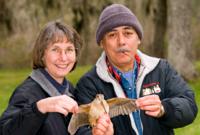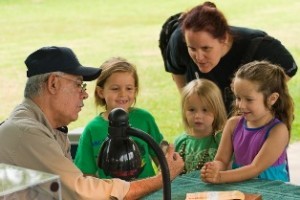You are invited to join us for our monthly bird banding program at the GCBO headquarters in Lake Jackson on the third Saturday of each month from 8 a.m. to 12 p.m. Licensed bird banders and GCBO Research Associates Robert and Kay Lookingbill band at the sanctuary on a regular basis. Birds are captured for banding in very fine nylon nets known as “mist nets” because they are almost invisible in the environment. Captured birds are weighed and measured and their species, sex, and age are recorded. Each is fitted with an aluminum leg band with a unique number provided by the U.S. Fish & Wildlife Service and released unharmed. If the bird is captured again, the band provides the link to retrieve this history, which then provides important information on the routes used by migrating birds, their longevity, and general physical condition.
The purpose of the project is to establish baseline data for the GCBO property on both resident and migratory bird populations. About half of the 34-acre headquarters tract is old growth Columbia Bottomland hardwood forest. The remaining acreage is partially cleared woodland with the larger trees remaining, the new constructed wetland, and the edges of Buffalo Camp Bayou. Banding will allow us to obtain information about the physical condition of migrants at this intermediate location between the coast and the bottomland forests lying well inland. Both coastal woodlots and inland bottomland forests are known to be extremely important stopover habitats for nearctic-neotropical migrants that move through the Gulf of Mexico region. Birds that are captured for banding can provide valuable information about their relative physical condition. Fat deposits, which provide the fuel necessary for the arduous undertaking of the twice annual travel of hundreds to thousands of miles, can be estimated by examining handheld birds. Recently arrived migrants generally exhibit little or no fat, as their fuel “tank” is depleted by the long flights they have just finished. The importance of stopover habitat to migrants is that it provides them with both shelter and a source of rapid replenishment of the fat reserves necessary to continue migration. In addition, bird banding is an excellent form of public outreach and education.
Please check our website or social media pages for any last minute changes in the monitoring dates. Funding for this program has been generously provided by a grant from the U.S. Fish and Wildlife Service Texas Coastal Program office in Clear Lake, Texas and ConocoPhillips Sweeny Refinery.


